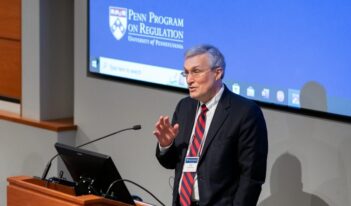
Assessing the past five years in regulation—and RegBlog’s achievements during this time—goes beyond numbers.
In the stage performance of the musical, Rent, Act 2 begins with a full-cast number that urges all of us to treasure the moments spent with friends and family. The song poses the question, “How do you measure a year in the life of a woman or a man?”
On RegBlog’s anniversary, I find myself wondering, how do you measure a year in the realm of regulation? Or, for that matter, five years?
Numbers themselves can be revealing. An electronic search of the government’s Federal Register yields exactly 13,750 final rules published from mid-April in 2011 to mid-April 2016. (Compare that to 723 new laws enacted by Congress from the beginning of 2011 to now.)
The White House Office of Information and Regulatory Affairs reports data on a total of 46 major federal rules issued since 2011 that have monetized impact estimates. Together, these 46 rules have yielded estimated annual benefits of up to $351 billion (in 2010 dollars), with annual costs as large as $43 billion.
But just as Rent’s lyricist suggests that life is about more than 525,600 minutes, the meaning of regulation lies in more than just its numbers. Regulation matters for the individual lives it affects.
That includes the individuals whose lives are lengthened by regulations that deliver health, safety, and environmental protection. It includes the people who receive greater access to medical care under health insurance regulatory reform.
But it also includes the owners of small businesses who face increased costs and paperwork burdens. And then there are the jobs lost—as well as the jobs created—by changes in the regulatory landscape.
Regulation is about more than just what government does. It is about the difference that governmental action, including inaction, makes in terms of individuals’ well-being.
It is perhaps fitting that this anniversary series begins on a day when the U.S. Supreme Court hears oral arguments in a case centered on executive branch reforms to the nation’s immigration system. RegBlog has covered this case on multiple occasions, so its significance will undoubtedly be clear. As the New York Times has noted, “more than four million unauthorized immigrants’ . . . lives could be transformed by the Supreme Court” decision in this case. Talk about “how do you measure.”
Throughout the last five years, RegBlog has racked up its own numbers covering these and other vital regulatory diverissues. It has published new content on over 1,300 consecutive weekdays, featuring a total of 1,485 stories and essays. Its readers, in more than 185 countries, have benefited from the work of 134 students serving as writers and editors, along with the insights of 211 outside contributors—including sitting federal judges, the heads of administrative agencies, former members of Congress, and the world’s foremost experts from law, economics, public policy, and political science.
But RegBlog is about more than numbers. It is actually about a simple idea: make the all-too-hidden world of regulation more accessible and understandable to the people directly affected by it. In the process of performing this public service, RegBlog also provides a vehicle for the students who produce it to learn about specialized topics in regulation as well as hone their professional skills in writing, working in teams, meeting deadlines, and paying attention to detail.
We celebrate RegBlog’s five-year anniversary this month because the website launched on its first magazine-style platform on April 5, 2011. On that date, RegBlog’s editors were privileged to publish three outstanding essays. One of the three essays was written by University of Pennsylvania Law School Dean Theodore Ruger, whose inaugural essay analyzed an important Supreme Court decision on the regulation of vaccine safety.
Another essay that day was authored by Penn Law Professor David Skeel, who focused on the challenges presented by the then-new Dodd-Frank Wall Street Reform and Consumer Protection Act. The day’s third essay was written by RegBlog’s first outside contributor: Abigail Slater, now the Vice President of Legal and Regulatory Policy for the Internet Association, who wrote about important developments in antitrust.
Those three inaugural essays exemplified what has become RegBlog’s hallmark: smart, well-written coverage of significant regulatory issues across a breadth of fields.
As the Penn Program on Regulation is a neutral, academic research center, RegBlog’s expert contributors have offered widely diverse viewpoints across the political spectrum. RegBlog’s student-led team of staff writers provides highly accessible and steadfastly balanced presentations of complex policy issues.
It says a lot about where RegBlog has come that, from its initial inauguration of three excellent essays, this year’s anniversary celebration has grown into a four-week series of superb, thought-provoking essays by 15 contributors. The five-fold increase is apropos for a five-year commemoration.
Especially given RegBlog’s religious commitment to accuracy, though, I do feel compelled to offer two modest footnotes on the occasion of this fifth anniversary. First of all, RegBlog’s history actually extends back beyond five years. It originally appeared as a literal blog on the Penn Program on Regulation’s website, with a very simple format of publishing a string of pithy “posts” on an occasional basis—content, in other words, more emblematic of a typical blog than of a sophisticated daily. Robert Jackel, who has long since graduated from Penn Law, served as my highly able research assistant at the time and helped prepare some of those occasional posts.
Notwithstanding this earlier history, what we celebrate this month are the five years that RegBlog has operated decidedly not as a blog, but as a regulation daily. This leads to my second footnote. For the last five years, RegBlog has, despite its name, amounted to much more than a blog. It is a daily, something produced no longer just with the help of a highly diligent research assistant. Now it is a polished operation run by a team of talented students who work tirelessly throughout the year to publish new material every weekday—even through holidays, exam periods, and academic breaks.
RegBlog owes its success over these past five years first and foremost to Jonathan Mincer, now a Penn Law alum, who served as RegBlog’s first editor in chief. Jonathan had the original vision for what RegBlog could become, and he worked heroically to make that vision a reality. RegBlog is still following a roadmap he laid out as early as 2010, when he first proposed building a student team to run RegBlog. His energy and experience made RegBlog sail through its start-up phase, and I am pleased he gave some of his precious spare time to contribute an essay of his own to this series.
Over the years, I have been privileged to advise an equally amazingly talented group of University of Pennsylvania students who have sustained RegBlog’s start-up momentum and taken this daily publication to new heights. Of course, readers’ patience will not permit me to name everyone who has given innumerable hours of work—and no doubt considerable sweat and tears—to make this public service possible. Such a list of people to acknowledge would include not only the students who served on RegBlog’s staff but also many members of the Penn Law administration and the school’s superb information technology staff.
I do want to acknowledge by name the six students or former students who have served as RegBlog’s editors in chief, for I have perhaps seen most closely the work that they have undertaken in shouldering the principal leadership of the organization: Jonathan Mincer, Sean Moloney, James Hobbs, Jessica Bassett, Alexandra Hamilton, and Kim Kirschenbaum. And I want to express an additional note of gratitude to those who played key roles in putting together this month’s RegBlog anniversary celebration, including Brandi Lupo and Sara Bodnar. I feel privileged to have known all of the students who have been involved in RegBlog and to see what they have accomplished.
What I have seen through the years, in what RegBlog’s team members have learned and in what they have achieved by way of informing the public about pivotal regulatory issues of our time, is truly something to measure a year—and five—in a most meaningful way. I can hardly wait for what unfolds during RegBlog’s second act: the next five years and beyond.
This essay is part of our sixteen-part series, RegBlog@5.




